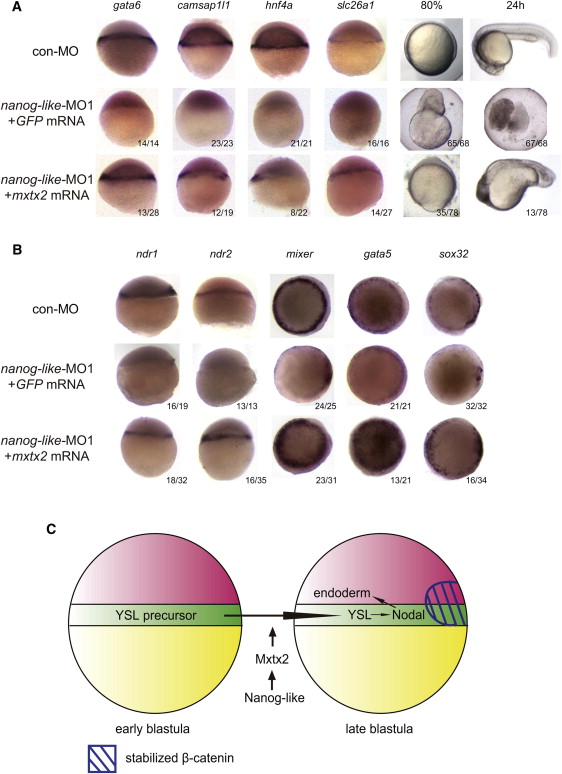Fig. 7
Fig. 7
mxtx2 Expression Rescues the nanog-like Morphant
(A) The YSL lineage was restored by mxtx2 expression in the nanog-like morphant. Lateral view of embryos injected with 10 ng control morpholino (con-MO) or 10 ng nanog-like morpholino (nanog-like-MO1). nanog-like-MO1-injected embryos were injected with either 100 pg GFP mRNA or 100 pg mxtx2 mRNA and 25 pg GFP mRNA at the four-cell stage. About one third of injected embryos had GFP expression in the YSL and were collected for further analysis. gata6 expression was rescued in 46% (13/28) of mxtx2-injected embryos; camsap1l1 expression was rescued in 63% (12/19) of mxtx2-injected embryos; hnf4a expression was rescued in 36% (8/22) of the mxtx2-injected embryos; and slc26a expression was rescued in 52% (14/27) of mxtx2-injected embryos. mxtx2 expression also rescued the yolk burst phenotype in the nanog-like morphant. At the 80% epiboly stage, 96% (65/68) GFP-injected nanog-like morphants showed the yolk burst phenotype, and 45% (35/78) nanog-like morphants having mxtx2 and GFP expression in the YSL showed normal epiboly progress. At 24 hpf, 99% (67/68) of GFP-injected nanog-like morphants were dead, and 17% (13/78) of nanog-like morphants having mxtx2 and GFP expression in the YSL showed axes rescue with defective head formation and body elongation.
(B) mxtx2 expression rescued the endoderm defect in the nanog-like morphant. Lateral view of embryos with dorsal side to the right. Ventrolateral ndr1 expression was rescued in 56% (18/32) of the embryos; ndr2 expression was rescued in 45% (16/35) of the embryos; mixer expression was rescued in 74% (23/31) of the embryos; gata5 expression was rescued in 62% (13/21) of the embryos; and sox32 expression was rescued in 47% (16/34) of the embryos.
(C) Model for endoderm and YSL induction. During early blastula development, the YSL precursor is formed by the collapse of marginal cells into the yolk cell. Acquisition of the YSL fate is mediated by Nanog-like through activation of the YSL master regulator Mxtx2. Stabilized β-catenin activates Nodal signals for endoderm induction in the dorsal region. The YSL and marginal blastomeres produce Nodal signals to induce the ventrolateral endoderm formation.
Reprinted from Developmental Cell, 22(3), Xu, C., Fan, Z.P., Müller, P., Fogley, R., Dibiase, A., Trompouki, E., Unternaehrer, J., Xiong, F., Torregroza, I., Evans, T., Megason, S.G., Daley, G.Q., Schier, A.F., Young, R.A., and Zon, L.I., Nanog-like Regulates Endoderm Formation through the Mxtx2-Nodal Pathway, 625-238, Copyright (2012) with permission from Elsevier. Full text @ Dev. Cell

